With the explosion of screens in all their forms, the Front-End has undergone profound transformations. Static, server-generated pages have given way to dynamically constructed interfaces rendered directly in the browser. Let’s take a look under the hood to discover the key stages in this [R]evolution!
The Front-End [R]evolution
- 09/01/2025
When servers were the only power behind browsers.
Before the advent of the first front-end frameworks, websites functioned mainly in a static, server-centric way. Each page was an independent HTML file, and clicking on a link triggered its complete reload, as asynchronous requests (AJAX) did not yet exist. As a result, sites lacked fluidity, and browsing was slow and jerky. Requests between the browser and the server were therefore heavier, as the entire page was requested each time, and this at a period when the internet speed for ordinary people was much lower than it is today.
At the time, JavaScript was rudimentary and inconsistent from one browser to another (Internet Explorer, Netscape, Firefox), which made it more difficult to manipulate the DOM. Even basic animations and interactions required complex, browser-specific code. The processing of forms and user actions relied almost exclusively on the server, which used technologies such as PHP, ASP, or JSP to dynamically generate HTML content before sending it to the client. This server-centric approach limited the user experience (UX) and hindered the creation of dynamic web applications.
Developers were forced to write repetitive, verbose, and often browser-specific code to carry out the simplest interactions. Collaboration on large-scale projects was hampered by a lack of standardisation, making code bases difficult to maintain and prone to errors. In addition, debugging tools were rudimentary by today’s standards, further complicating the development process. These limitations eventually led to a demand for frameworks that could abstract complexity, promote consistency, and streamline the development of dynamic, scalable web applications.
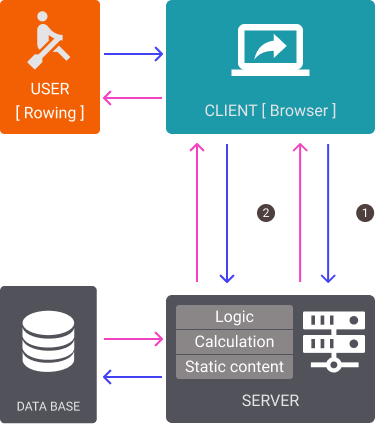
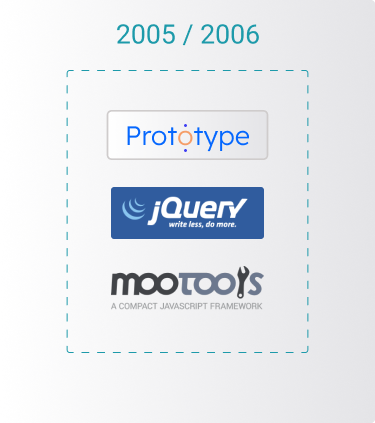
The Foundations of Modern Front-End
From 2005 onwards, things began to change on the client side with the emergence of libraries such as Prototype.js (2005), jQuery (2006), and MooTools (2006), which revolutionized the use of JavaScript. These tools were designed to address the limitations of this language by providing developers with consistent APIs for DOM manipulation, asynchronous event handling, and XML data querying (AJAX).
Prototype.js laid the groundwork by introducing utilities that simplified previously arduous and error-prone logic. However, it was jQuery that truly democratized JavaScript. With its motto, “Write less, do more,” jQuery enabled developers of all levels to create dynamic, interactive web pages—often eclipsing Adobe’s Flash technology—while alleviating cross-browser compatibility issues. MooTools, though less popular, introduced advanced concepts such as object-oriented programming (OOP) and JavaScript classes, inspiring future frameworks that would revolutionize front-end development.
These libraries significantly simplified the use of JavaScript, empowering developers to build richer, more dynamic web applications without needing to reload entire pages to update just a few pieces of information. They not only established standards for front-end development practices but also showcased JavaScript’s potential as the cornerstone of web interactivity. This wave of innovation marked the start of a new era focused on enhancing user experience (UX). The release of the first iPhone in 2007 further accelerated this trend, with some web applications becoming powerful enough to rival Apple’s native apps.
With the adoption of modern browsers and the growing popularity of AJAX, many developers began to create Single Page Applications (SPAs). It was no longer the server that generated all the pages of a web application, but the client (browser) that retrieved only the necessary information via XHR requests, then directly updated the relevant parts of the DOM.
The rise of SPAs significantly enhanced the user experience (UX) of SaaS applications. Although SaaS as a concept predates SPAs—it had already gained traction with solutions like Salesforce in the early 2000s—the advent of SPAs brought a new level of interactivity and responsiveness to these web-based platforms. However, they were also harder to maintain due to their often chaotic architectures. At the time, there was no JavaScript framework for structuring code, and the language’s inherent difficulties (such as the absence of static typing) made development even more complex. As a result, JavaScript acquired a rather poor reputation among experienced developers, who often mocked the language—and those who used it—online.

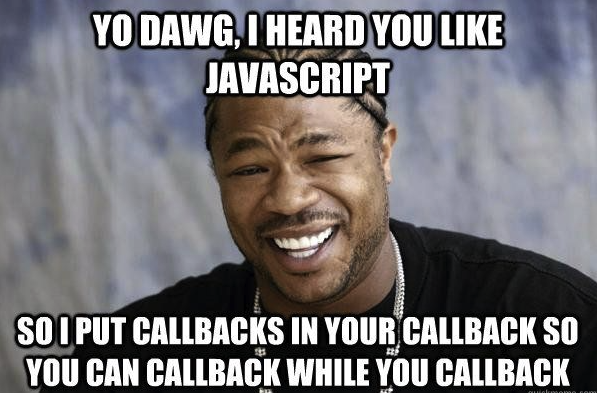

The age of javascript architectural frameworks
The early 2010s saw the rise of frameworks based on well-established design patterns such as Model-View-Controller (MVC), inspired by Ruby on Rails, and Model-View-ViewModel (MVVM), influenced by Microsoft’s WPF and Silverlight architectures.
- Backbone.js (2010): Created by Jeremy Ashkenas, Backbone.js adopted the MVC architecture, strongly influenced by the need for a lightweight, flexible framework to manage data and views in a scalable way. It introduced models, views, and collections into front-end development as one of the first attempts to structure client-side applications, providing a solid foundation for better architecture and scalability.
- Knockout.js (2010): Developed by Steve Sanderson, Knockout.js introduced the MVVM pattern, focusing on simplifying data binding between the model and the user interface. By enabling two-way data binding between the model and the view, it became a key contributor to the evolution of data-driven front-end design, influencing future frameworks like AngularJS.
- Ember.js (2011): Initially designed by Yehuda Katz, Ember.js was inspired by Ruby on Rails, adopting conventions such as “convention over configuration” and introducing a robust routing system. Starting with an MVC-inspired architecture, Ember evolved to incorporate elements of MVVM, including features such as bidirectional data binding and a component-based architecture, making it a comprehensive solution for building single-page applications (SPAs).
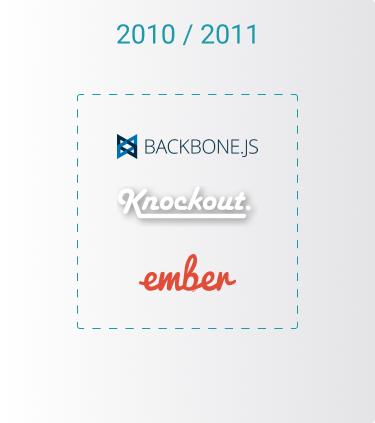
Drawing on different paradigms, these frameworks have revolutionized front-end development, offering tailor-made solutions for managing complexity, fostering collaboration, and creating user-centric experiences. Their diverse influences have laid the foundations for the modern tools developers rely on today.
However, despite these significant advances in the JavaScript ecosystem, critics from the world of “more serious” languages such as Java, Python, ASP.NET, and Ruby continued to find reasons to mock it. This was particularly true with the emergence of Node.js in 2009, which marked a turning point by introducing JavaScript into backend development and challenging the dominance of these established languages.
JavaScript’s permissiveness, lack of typing, and quirky behaviors (such as confusing equality operations and frequent runtime errors) remained popular targets of criticism, earning it the nickname “duct tape of the web”.
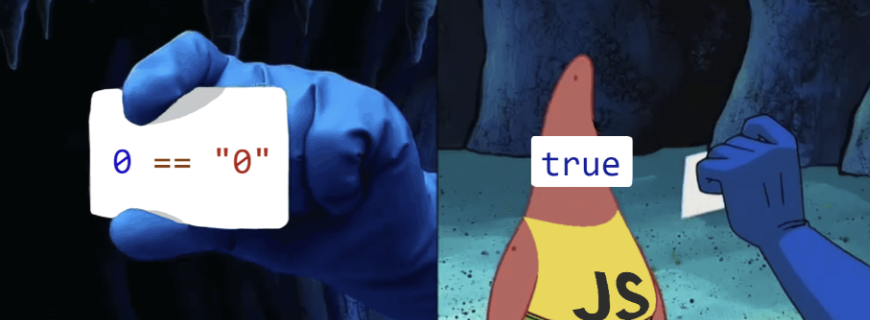



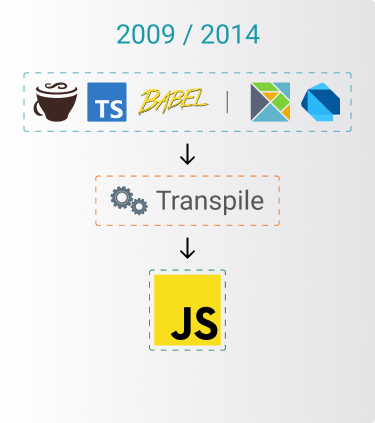
The rise of JavaScript transpilers
Transpilers emerged as tools that converted code written in alternative syntaxes into JavaScript, enabling developers to leverage advanced functionality, improve productivity, and ensure cross-browser compatibility. These tools not only simplified development but also shaped the future of JavaScript itself.
- CoffeeScript (2009): Created by Jeremy Ashkenas, CoffeeScript was one of the first transpilers to make a significant impact. Inspired by Ruby and Python, it introduced a concise and readable syntax, enabling developers to write elegant code that compiled into clean JavaScript. CoffeeScript’s influence was profound, with several of its ideas—such as arrow functions—later adopted into the ECMAScript standards.
- TypeScript (2012): Developed by Microsoft and led by Anders Hejlsberg, the creator of C#, TypeScript introduced a powerful layer of static typing and object-oriented functionality to JavaScript. Addressing JavaScript’s lack of type safety, TypeScript made it easier to manage large-scale applications. Its enterprise-grade capabilities and seamless integration with modern development tools led to widespread adoption, significantly influencing the evolution of JavaScript.
- Babel (2014): Formerly known as 6to5, Babel was introduced by Sebastian McKenzie and has been pivotal in the adoption of ECMAScript 6+ features. By transpiling modern JavaScript syntax into backward-compatible versions, Babel allowed developers to use the latest JavaScript innovations without waiting for full browser support. It quickly became the cornerstone of front-end tools, significantly accelerating the adoption of ES6 and beyond.
- Dart (2011): Developed by Google, Dart aimed to replace JavaScript as the dominant language for web development. Although it fell short of this ambitious goal, Dart succeeded in compiling to JavaScript, enabling developers to build fast and maintainable web applications. Moreover, Dart laid the groundwork for Flutter, a popular framework for cross-platform development.
- Elm (2012): Created by Evan Czaplicki, Elm brought a purely functional programming approach to front-end development. Focused on creating reliable web applications, Elm emphasized immutability and type safety, compiling to JavaScript for execution. Although it remains a niche tool, Elm has inspired the integration of functional programming concepts and best practices into mainstream JavaScript.
And about JS package managers?
The introduction of npm (Node Package Manager) in 2010 brought a monumental change to the way JavaScript projects managed dependencies. By introducing the node_modules directory, npm centralized the storage and organization of packages, enabling developers to share and reuse code easily. However, this system became infamous for its “dependency hell,” as packages often included numerous nested dependencies, resulting in massive directory sizes and maintenance headaches.
With the growing complexity of front-end development, alternative package managers emerged to address these issues. Yarn (2016), created by the Facebook engineering team and spearheaded by Sebastian McKenzie, focused on speed and reliability, introducing a lockfile mechanism to ensure deterministic installations. pnpm (2016), developed by Zoltan Kochan, took a different approach, using deduplication and symbolic links to prevent redundant package installations and minimize disk space usage.
In recent years, npm has bridged the gap by adopting features inspired by these competitors, such as improved caching, parallel installations, and enhanced deduplication. These innovations have reduced overhead and streamlined workflows, making npm a more competitive and efficient tool in the JavaScript ecosystem.

Last but not least: the JS development toolchain !
The evolution of front-end tools has significantly advanced the way developers manage complexity in web development. Task runners like Grunt (2012, created by Ben Alman) and Gulp (2013, created by Eric Schoffstall) automated repetitive tasks such as compiling styles and live browser refreshing, streamlining workflows and saving developers time.
Code minifiers like UglifyJS (2010, by Mihai Bazon) played a pivotal role in reducing file sizes, improving page load times and performance. Later tools like Terser and esbuild built upon these foundations, delivering faster and more efficient optimization processes.
Module bundlers revolutionized dependency management and resource integration. Browserify (2011, by James Halliday) introduced Node.js-style modules to the browser, while Webpack (2012, created by Tobias Koppers) extended this concept by bundling JavaScript, CSS, images, and other assets, enabling the creation of modular and scalable applications. Parcel (2017) and Vite (2020, created by Evan You) followed, focusing on simplicity, speed, and zero-configuration development.
The advent of ES modules further transformed workflows, with tools like SystemJS (2014, by Guy Bedford) bridging the gap until native browser support for modern module loading became robust.
Today, unified tools like Webpack and Vite embody the industry’s shift towards simplicity, performance, and developer-centric design. Webpack has established itself as a backbone for modern front-end workflows, bundling not just JavaScript but also CSS, images, and other assets. Vite, leveraging modern browser capabilities and ES modules, has streamlined the development experience with its lightning-fast performance and zero-configuration approach, redefining efficiency in front-end development.
Finally, here we are!
From static pages to SPAs, and from early frameworks like Backbone.js to modern giants like React, Vue.js, Angular, Svelte, and SolidJS, the journey highlights how creativity and innovation have continuously pushed the boundaries of front-end development. These tools have not only shaped the way we build applications but also how users interact with them—focusing on performance, scalability, and seamless user experiences.
- React (2013): Developed by Facebook, React revolutionized front-end development with its component-based architecture and virtual DOM, empowering developers to build highly interactive and dynamic applications. Its ecosystem has become the foundation for modern tools like Next.js, making React the go-to framework for many developers.
- Vue.js (2014): Created by Evan You, Vue.js is celebrated for its simplicity and versatility. Its progressive nature allows developers to adopt features incrementally, making it an excellent choice for both small projects and complex applications. Tools like Nuxt.js further enhance its capabilities with server-side rendering and static site generation.
- Angular: Now in its latest versions (Angular 15 and beyond), Angular is a complete framework backed by Google. It boasts a powerful CLI, two-way data binding, and features like standalone components, which simplify application architecture. Angular remains a robust choice for large-scale, enterprise-level applications.
- Svelte (2016): Introduced by Rich Harris, Svelte takes a unique approach by compiling components into pure JavaScript at build time, eliminating the runtime overhead found in other frameworks. Its lightweight nature and simplicity have made it increasingly popular for creating performant web apps.
- SolidJS: Created by Ryan Carniato, SolidJS offers a fine-grained reactivity model, inspired by React’s principles but optimized for performance. Its approach to reactivity eliminates unnecessary re-renders, making it one of the fastest frameworks for creating highly reactive user interfaces.
What’s Next?
Although I’ve covered the key events and technologies in front-end transformations from the 2000s to the present day, several important concepts couldn’t be explored so this article won’t take half a day to read :). I’ll try to cover them in future articles, but here’s a non-exhaustive list of topics that come to mind:
- Progressive Web Apps (PWA): Bridging the gap between web and native applications.
- Automated Testing: Tools such as Jest, Cypress, Mocha, Protractor have revolutionized QA and maintainability through robust end-to-end and unit testing.
- Server-Side Rendering (SSR) and Static Site Generation (SSG): How to improve SEO while optimizing performance.
- Web Components: Building reusable components encapsulated natively in the browser.
- GraphQL and API Evolution: Redefining the way front-end and back-end communicate.
- Micro-Frontends: A modular approach to large-scale applications.
- State Management Patterns: From Redux to Pinia, managing complexity in SPAs.
- WebAssembly (Wasm): A paradigm shift for high-performance code execution in the browser (Gaming, Data Visualization, Finance, CAD App).
- Cross-Platform Development: The role of frameworks like Flutter and React Native.
- Web Security Practices: Navigating the challenges of front-end vulnerabilities.
By diving into these topics, we’ll continue to explore the innovations that define modern web development and the exciting possibilities that lie ahead for the front-end ecosystem.
Stay tuned—there’s much more to discover!
@nthoGac
SaaS Engineer & Writer

